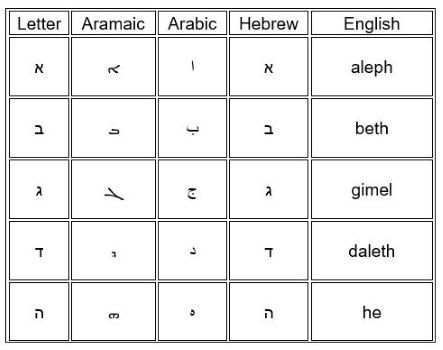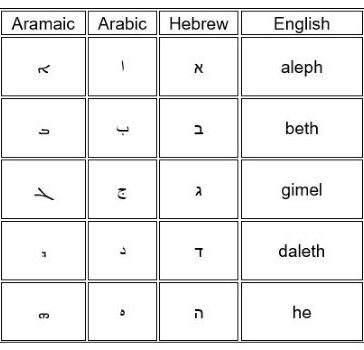Aramaic is a Semitic language that was spoken by Jesus, his disciples, and many of the people they encountered. It originated in the region of Aram, which is located in present-day Syria. Moreover, Aramaic was the lingua franca of the Middle East during the first century AD.
Introduction
The captivating allure of Aramaic, the language spoken by Jesus
Ever wondered what language did Jesus speak?
Jesus and his disciples spoke Aramaic, and many of the early Christian writings were composed in Aramaic. Aramaic played a significant role in the early development of Christianity.
The New Testament contains a number of Aramaic words and phrases. The use of Aramaic in the early Christian church helped to spread Christianity throughout the Middle East. Aramaic was a language that was understood by people from a variety of backgrounds.

Unraveling the historical significance of Aramaic and its widespread influence
Aramaic began to be spoken in the region of Aram around the 12th century BC. By the 8th century BC, it had become the lingua franca of the Assyrian Empire. After the fall of the Assyrian Empire, Aramaic continued to be spoken throughout the Middle East.
In the first century AD, Aramaic was the most widely spoken language in Palestine. More specifically, it was the language of the common people, and was used in both everyday conversation and in religious contexts.
Few centuries later, Aramaic was divided in West and East variants. West Aramaic dialects examples include Nabataean (formerly spoken in parts of Arabia) and Palmyrene (spoken in Palmyra, near Damascus). West Neo-Aramaic is still spoken in small numbers of villages across Syria. It is still spoken by just a few thousand people living in the Anti-Lebanon Mountains of Syria, mostly within Maaloula, Jubb’adin and Bakhah.
East Aramaic includes Syriac, Mandaean, Eastern Neo-Assyrian, and the Aramaic of the Babylonian Talmud. One of the most crucial of them is Syriac, the main language in a vast literary corpus from the 3rd to seventh century. Mandaean could be described as the language of the gnostic sect that was centered within the region of lower Mesopotamia. East Aramaic is still spoken by small groups from Jacobite or Nestorian Christians within the Middle East.
Embarking on a journey of linguistic discovery, uncovering the beauty and complexity of Aramaic
Aramaic is no longer a widely spoken language, but it has had a lasting impact on the world. It is the language of the Talmud, the Targums, and many other important Jewish texts. It is also the language of several early Christian writings.
Aramaic has also influenced a number of other languages, including Hebrew, Arabic, and English. For example, the English word “amen” is derived from the Aramaic word “amen”.
The study of Aramaic can provide insights into the history, culture, and religion of the Middle East. It can also help us to better understand the early development of Christianity.
Aramaic: A Linguistic Tapestry of The Language Spoken by Jesus
Delving into the intricacies of the Aramaic alphabet, pronunciation, and grammar
The Aramaic alphabet has 22 letters, the Arabic alphabet has 28 letters, and the Hebrew alphabet has 22 letters. The three alphabets are all written from right to left.
Here is a table of the Aramaic, Arabic, and Hebrew alphabets, along with their English equivalents:
| Letter | Aramaic | Arabic | Hebrew | English |
| א | ܐ | ا | א | aleph |
| ב | ܒ | ب | ב | beth |
| ג | ܓ | ج | ג | gimel |
| ד | ܕ | د | ד | daleth |
| ה | ܗ | ه | ה | he |
| ו | ܘ | و | ו | waw |
| ז | ܙ | ز | ז | zayin |
| ח | ܚ | ح | ח | heth |
| ט | ܛ | ط | ט | teth |
| י | ܝ | ي | י | yodh |
| כ | ܟ | ك | כ | kaf |
| ל | ܠ | ل | ל | lamedh |
| מ | ܡ | م | מ | mem |
| נ | ܢ | ن | נ | nun |
| ס | ܣ | س | ס | samekh |
| ע | ܥ | ع | ע | ayin |
| פ | ܦ | ف | פ | pe |
| צ | ܨ | ص | צ | tsade |
| ק | ܩ | ق | ק | qoph |
| ר | ܪ | ر | ר | resh |
| ש | ܫ | ش | ש | shin |
| ת | ܬ | ت | ת | taw |
Exploring the nuances of biblical Aramaic, gaining insights into its unique features
Biblical Aramaic has a number of unique features that distinguish it from other Semitic languages.
- Loanwords: Biblical Aramaic contains a number of loanwords from Persian, Babylonian, and Greek. This reflects the influence of these cultures on the Aramaic-speaking people of the time.
- Grammar: Biblical Aramaic grammar is similar to Hebrew grammar, but there are some important differences. For example, biblical Aramaic verbs are conjugated differently than Hebrew verbs.
- Vocabulary: Biblical Aramaic has a number of unique words and phrases that are not found in other Semitic languages. These words and phrases often reflect the cultural and religious context in which biblical Aramaic was spoken.
Biblical Aramaic was the language in which portions of the Bible were written. By understanding biblical Aramaic, we can gain a deeper understanding of the meaning of these biblical texts.
Uncovering the fascinating connections between Aramaic, Hebrew, and Arabic: Aramaic vs. Hebrew & Aramaic vs. Arabic
Aramaic, Arabic, and Hebrew are three closely related Semitic languages. They share a common ancestor, Proto-Semitic, and they all have many similarities in their alphabets, pronunciation, and grammar. However, there are also some important differences between the three languages.
Here are some of the key differences between Aramaic, Arabic, and Hebrew:
- Aramaic is written from right to left, while Arabic and Hebrew are written from right to left.
- Aramaic has 22 letters, while Arabic has 28 letters and Hebrew has 22 letters.
- Aramaic has some unique letters that are not found in Arabic or Hebrew.
- The pronunciation and grammar of Aramaic is similar to Arabic and Hebrew, but there are some differences.
Vocabulary Examples in Aramaic – The Language Spoken by Jesus
Have you ever wondered how to say “God” in Aramaic? Or what is Jesus name in Aramaic? Let us look at some words:
- ܐܠܗܐ (ʼĔlāhā): is the Aramaic word for God. We use “Alaha” to refer to “God” in Aramaic.
- ܝܫܘܥ (Isho): is Jesus name in Aramaic.
- ܐܕܡ (Adam): is the name Adam in Aramaic.
Notice the similarities with “Elohim” in Hebrew, “Alaha” in Syriac Aramaic, and “Allah” in Arabic. Allah refers to the God creator, The One and Only God.
It should be noted that, although the word “Elohim” in Hebrew is plural, it does not refer to a plural in numbers, but rather in the standing or status, similar to the majestic plural in English.
Embarking on Your Own Aramaic Journey
Discovering effective resources for learning Aramaic – The Language Spoken by Jesus
If you are interested in learning Aramaic, there are a number of resources available to you. There are textbooks, online courses, and even apps that can help you to learn the basics of Aramaic.
Here are a few tips for learning Aramaic:
- Start by learning the Aramaic alphabet. Once you know the alphabet, you can start to learn basic vocabulary and grammar.
- Find a learning resource that works for you. There are many different ways to learn Aramaic, so find a resource that is both effective and enjoyable for you.
- Be consistent with your studies. The best way to learn Aramaic is to practice regularly. Try using Anki flashcards to help you memorize vocabulary and basic grammar rules.
Conclusion
Aramaic is a fascinating language with a rich history. Aramaic is the language spoken by Jesus and his disciples, and it has had a profound impact on the world. The study of Aramaic can help us to better understand the past and to gain insights into the present.
Aramaic, Arabic, and Hebrew are three closely related Semitic languages. They share a common ancestor, and they all have many similarities in their alphabets, pronunciation, and grammar.


